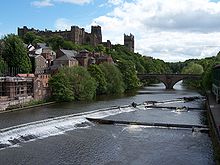
Durham is a cathedral city and civil parish in the county of Durham, England. It is the county town and contains the headquarters of Durham County Council, the unitary authority which governs the district of County Durham. It had a population of 48,069 at the 2011 Census.

University College, informally known as Castle, is a college of Durham University in Durham, England. Centred on Durham Castle on Palace Green, it was founded in 1832 and is the oldest of Durham's colleges. As a constituent college of Durham University, it is listed as a higher education institution under section 216 of the Education Reform Act 1988. Almost all academic activities, such as research and tutoring, occur at a university level.

Durham Cathedral, formally the Cathedral Church of Christ, Blessed Mary the Virgin and St Cuthbert of Durham, is a Church of England cathedral in the city of Durham, England. The cathedral is the seat of the bishop of Durham and is the mother church of the diocese of Durham. It also contains the shrines of the Anglo-Saxon saints Cuthbert and Bede. There are daily Church of England services at the cathedral, and it received 727,367 visitors in 2019. It is a grade I listed building and forms part of the Durham Castle and Cathedral World Heritage Site.

County Durham, officially simply Durham (/ˈdʌrəm/), is a ceremonial county in North East England. The county borders Northumberland and Tyne and Wear to the north, the North Sea to the east, North Yorkshire to the south, and Cumbria to the west. The largest settlement is Darlington, and the county town is the city of Durham.

The term Norman architecture is used to categorise styles of Romanesque architecture developed by the Normans in the various lands under their dominion or influence in the 11th and 12th centuries. In particular the term is traditionally used for English Romanesque architecture. The Normans introduced large numbers of castles and fortifications including Norman keeps, and at the same time monasteries, abbeys, churches and cathedrals, in a style characterised by the usual Romanesque rounded arches and especially massive proportions compared to other regional variations of the style.

William Van Mildert was the bishop of Durham (1826–1836), and the last to rule the county palatine of Durham. He was also one of the founders of the University of Durham, where he is commemorated in the names of Van Mildert College, founded in 1965, and the Van Mildert Professor of Divinity.
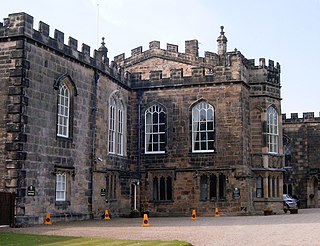
Auckland Castle, which is also known as Auckland Palace and to people that live locally as the Bishop's Castle or Bishop's Palace, is located in the town of Bishop Auckland in County Durham, England. In 1832, this castle replaced Durham Castle as the official residence of the Bishops of Durham. It is now a tourist attraction, but still houses the Bishop's offices; the Castle is a Grade I listed building.
Hugh de Puiset was a medieval Bishop of Durham and Chief Justiciar of England under King Richard I. He was the nephew of King Stephen of England and Henry of Blois, who both assisted Hugh's ecclesiastical career. He held the office of treasurer of York for a number of years, which led him into conflict with Henry Murdac, Archbishop of York. In 1153, Hugh was elected bishop of Durham despite the opposition of Murdac.

The Bailey is a historic area in the centre of the city of Durham, County Durham, England. It consists of two streets, North Bailey and South Bailey. It is on a peninsula within a sharp meander along the River Wear, formed by an isostatic adjustment of the land. The name "The Bailey" derives from the outer bailey of the Norman motte and bailey-style Durham Castle. Vehicular access to the area is restricted by the Durham City congestion charge, which started in 2002 and is the UK's oldest such scheme.

Pickering Castle is a motte-and-bailey fortification in Pickering, North Yorkshire, England.

The Diocese of Durham is a Church of England diocese, based in Durham, and covering the historic county of Durham. It was created in AD 635 as the Diocese of Lindisfarne. The cathedral is Durham Cathedral and the bishop is the Bishop of Durham who used to live at Auckland Castle, Bishop Auckland, and still has his office there. The diocese's administrative centre, the Diocesan Office, is located at Cuthbert House, Stonebridge just outside Durham City. This was opened in 2015.
Walcher was the bishop of Durham from 1071, a Lotharingian and the first Prince-bishop. He was the first non-Englishman to hold that see and an appointee of William the Conqueror following the Harrying of the North. He was murdered in 1080, which led William to send an army into Northumbria to harry the region again.
Uhtred of Bamburgh, was ruler of Bamburgh and from 1006 to 1016 the ealdorman of Northumbria. He was the son of Waltheof I, ruler of Bamburgh (Bebbanburg), whose family the Eadwulfings had ruled the surrounding region for over a century. Uhtred's death by assassination was described in De obsessione Dunelmi and has been interpreted as the beginning of a blood feud. Not to be confused with Uhtred the son of Eadwulf I of Bamburgh, which is why he historically has been referred to as Uhtred the Bold.
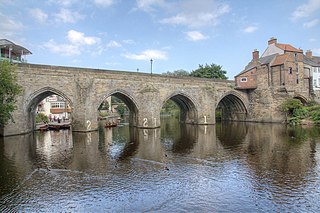
Elvet Bridge is a medieval masonry arch bridge across the River Wear in the city of Durham, in County Durham, England. It links the peninsula in central Durham and the Elvet area of the city, and is a Grade I listed building.
Æthelwine was the last Anglo-Saxon bishop of Durham, the last who was not also a secular ruler, and the only English bishop at the time of the Norman Conquest who did not remain loyal to King William the Conqueror.

The County Palatine of Durham was a jurisdiction in the North of England, within which the bishop of Durham had rights usually exclusive to the monarch. It developed from the Liberty of Durham, which emerged in the Anglo-Saxon period. The gradual acquisition of powers by the bishops led to Durham being recognised as a palatinate by the late thirteenth century. Durham was one of several counties palatine in England during the Middle Ages, but was noted for having an exceptionally wide range of powers and independence from the monarch. The county palatine had its own government and institutions, which broadly mirrored those of the monarch and included several judicial courts. From the sixteenth century the palatine rights of the bishops were gradually reduced, and were finally abolished in 1836. The last palatine institution to survive was the court of chancery, which was abolished in 1972.
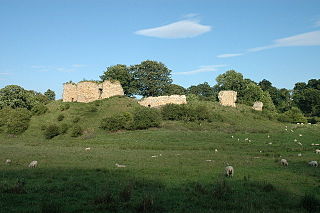
Mitford Castle is an English castle dating from the end of the 11th century and located at Mitford, Northumberland. It is a Scheduled Ancient Monument and a Grade I listed building, enlisted on 20 October 1969. The castle is also officially on the Buildings at Risk Register. The Norman motte and bailey castle stands on a small prominence, a somewhat elliptical mound, above the River Wansbeck. The selected building site allowed for the natural hill to be scarped and ditched, producing the motte.
Events from the 1080s in England.
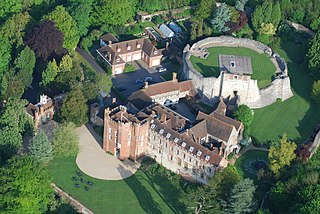
Farnham Castle is a 12th-century castle in Farnham, Surrey, England. It was formerly the residence of the Bishops of Winchester.

Crayke Castle is a Grade I listed 15th-century castle in Crayke, North Yorkshire, England. The castle consists of a restored 15th-century four-storey tower house with attached outbuildings to the rear and a separate ruined 15th-century tower, the "New Tower". It is situated on Church Hill in the village of Crayke.




